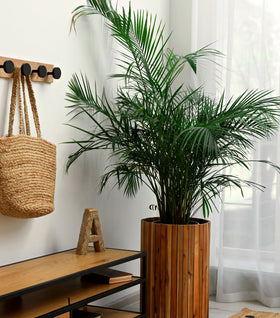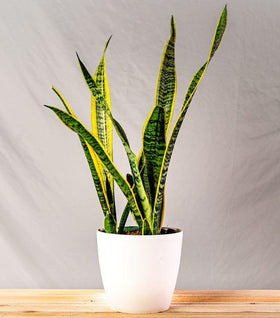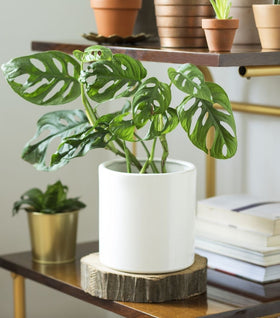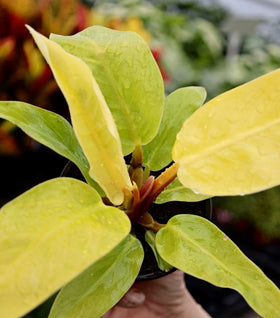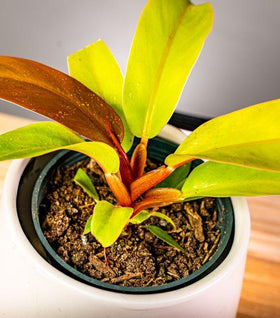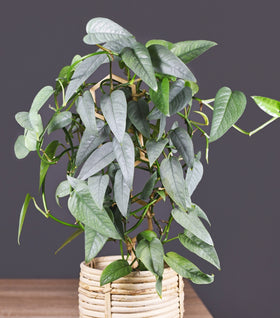Clean Air Plants for Sale Online
For many homeowners, plants are used as an air cleaning machine indoors. They offer striking foliage that complements your home's features and cleanses the air throughout your home of indoor air pollution. It is a significant benefit when considering the various toxins throughout today's homes, such as formaldehyde, benzene, carbon monoxide, and carcinogens.
If you're looking to add plants to your home, consider Garden Goods Directs selection of clean air houseplants for sale online and shipped directly to your home. Not only will you add beauty to your home but function as well.
Buying Air Purifying Plants Online
Whether you know it or not some of our most common houseplants are air-cleaning machines. English Ivy, Bamboo Palms, and even the beautiful Peace Lily absorb toxins and provide us with oxygen in our homes. When you add this benefit to the soothing effects plants provide for us, having clean air indoor plants in the home is a win-win situation.
Types of Clean Air Plants
At Garden Goods Direct, we offer several varieties of air-cleaning plant species for sale online, including:
- Peace lilies: Peace Lilies are excellent for removing alcohols, acetone, trichloroethylene, benzene, and formaldehyde from indoor air. Spathiphyllum also has a high transpiration rate that both purifies and humidifies indoor air. the ribbed, glossy green leaves match any decor and the plant produce the characteristic white flower. Peace lilies are one of the few clean-air plants that bloom indoors.
- Boston Fern: Boston Fern is said to purify the air better than any other plant that was tested. It thrives in low light and requires little care.
- Chinese evergreens or Aglaonema: We love Chinese evergreens. They are extremely resilient houseplants and are among the easiest houseplants to grow. Aglaonema doesn't mind if you forget to water, it or if you grow it in low, medium, or bright light situations.
- Palms: Palm trees are another plant that scored very high in NASA's tests. Their ability to remove formaldehyde, benzene, and trichloroethylene from the air is second to none. As an added bonus the lacy, green fans add humidity to the air.
- Philodendrons: Philodendrons prefer medium light but will tolerate lower light conditions. The Split-Leaf philodendron is probably the most popular philodendron because of its ability to grow anywhere and everywhere indoors. Monstera also climbs and can reach a height of six feet when properly supported. Be careful with the direct sun as it can burn the leaves of most philodendrons and stunt plant growth.
- Spider Plants: Spider Plants are a champion cleanser of air and are very easy to grow. The NASA tests showed it can remove around 90% of the cancer-causing chemical known as formaldehyde from the air. Keep a spider plant around your kitchen and bathrooms as they love the additional humidity.
- Pothos: Pothos or Devil's Ivy is a powerful plant in the fight against formaldehyde. It grows in a cascade of green, yellow, or silver. It does well in a hanging basket or grown on top of cabinets or bookshelves where it can be allowed to hang.
-
Snake Plants: Snake plants are an old-time houseplant that is seeing a major resurgence in popularity (also known as Mother In Law Tongue). They are ideal for creating a modern, contemporary look. with its sculptural, sword-like leaves it adds a vertical dimension to any decor.
Sansevierias are also the easiest of all houseplants to grow which makes it ideal for beginner plant parents to add clean-air plants to their living space. Snake Plants do their work at night while we sleep which is why they are ideal plants for the bedroom. - ZZ plants: The ZZ Plant is one of the toughest indoor plants available today. They are equally able to thrive in areas with low and high amounts of light. The ZZ plant is known to remove Toluene and Xylene from indoor air.
Why Use Clean Air Plants?
Toxins are present in the air we breathe at home and at the office. In fact, the three most common household toxins are benzene, formaldehyde, and trichloroethylene. But how do these toxins get into our homes? Products manufactured with synthetic substances and materials emit toxins into your home. By introducing clean air plants into your home or office you can remove these toxins from your home.
The benefits of clean air houseplants don't stop with just removing man-made toxins, they also extend to allergies, asthma, and several other diseases. With clean air indoor plants throughout your home, you can lower your risk for those diseases and improve your blood pressure as well. No matter your age or current health, it’s a significant benefit to you and your family and helps you follow a greener more holistic way of life.
Recent improvements in building products and techniques have caused a new phenomenon known as sick building syndrome. Sick building syndrome or "SBS" is used to describe a condition in which the occupants of an office building experience health or comfort-related symptoms that seem to be linked directly to the time spent in the building. No specific illness or cause can be identified. The complainants may be localized in a particular room or they may be widespread throughout the building or office.
This is in fact caused by windows and homes being built so tight to increase the heating or cooling efficiency of the building or home. In years past the indoor air of buildings and homes would turn over about once per hour with outside air. This means that the air inside would be replaced by outdoor air. Currently, energy-efficient buildings and homes rarely turn over if at all.
What are the symptoms of SBS?
Symptoms of Sick Building Syndrome or "SBS" include headache, dizziness, nausea, eye, nose, or throat irritation, dry cough, dry or itching skin, difficulty in concentration, fatigue, sensitivity to odors, hoarseness of voice, allergies, colds, flu-like symptoms, increased incidence of asthma attacks and personality changes.
The cause of the symptoms is not known but it is a major cause of reduced work efficiency and increases in absenteeism. Most of the complainants report relief soon after leaving the building.
Tips for Choosing the Right Type of Clean Air Plants
Because each family of plants has targeted toxins they absorb, many indoor gardeners buy clean-air plants that focus on select toxins, such as a peace lily for mold spores. While shopping for clean air plants, it’s valuable to consider other factors, such as what that plant requires as far as light, moisture, and temperature.
A happy indoor plant will remove the most toxins and release oxygen back into the air. Since it’s best to place clean-air plants in clusters, you’ll also have to think about where you’ll set them.
The majority of the house plants that remove pollutants come from tropical forests where they only get light filtered through the canopy of taller trees. This means that clean-air plants are very efficient at using low light levels to stay green and healthy. They also are very good at drawing in air to the plant itself since the air in their native regions doesn't move like the air on the open plains.
Another little-known benefit of having living plants in the home is the soil and roots also remove air-borne pollution. Naturally occurring bacteria and fungi found in soil use pollutants as a food source to feed plant roots. when you remove the lower leaves on your plants to expose as much of the soil surface as possible, even more, toxins can be absorbed to feed plants.
More often than not common houseplants are the most efficient. Some of America's favorite plants like Snake plants, Majesty Palm, and Split Leaf Philodendron are on NASA's top plant list.
The Landscape Contractors of America have recently begun studying the effects of clean air plants in malls and other indoor public spaces.
How to Use Clean Air Plants in Homes
For the best purification of your home’s air, you’ll want to cluster your plants together. If that’s not an ideal setup for your home and you need to resituate your potted plants, that’s all right.
What is essential is making sure your plants receive the proper plant care, which starts with a quality potting mix and continues with watering, feeding, pruning, and re-potting (when needed) as your clean-air plants grow. Clean air plants can be chosen based on your indoor decor. Sizes can range from a 6" Chinese evergreen plant to a 10" Bamboo palm and everything in between.
How Many Clean Air Plants do I need?
The NASA studies on indoor pollution that were done in 1989 recommend that you have 15 to 18 plants to clean the air in an average 1,800-square-foot house. That's roughly one air-purifying plant per 100 square feet of floor space.
Buy Clean Air Plants From Garden Goods Direct Today
Whether you’re interested in the beauty of indoor houseplants or the green power of clean-air plants, bringing gardening into your home is something you’re sure to love. At Garden Goods Direct, we help you start cleaning your house of toxins by providing an eye-catching selection of trusted plants for improving air quality. Contact one of our plant experts and we'll be more than happy to offer some suggestions.
For more information on how to repot a houseplant, follow the steps in our planting guide: How to Repot a Plant.

















